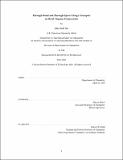Through-bond and through-space charge transport in metal-organic frameworks
Author(s)
Xie, Lilia Shell.
Download1192965980-MIT.pdf (40.12Mb)
Other Contributors
Massachusetts Institute of Technology. Department of Chemistry.
Advisor
Mircea Dincă.
Terms of use
Metadata
Show full item recordAbstract
Electrically conductive metal-organic frameworks (MOFs) combine intrinsic porosity with efficient charge transport, opening up possibilities as active materials for applications ranging from electrocatalysis to chemiresistive sensing. In this thesis, efforts to study and control the conductivities of MOFs with different structural motifs enabling charge transport are detailed. Chapter 1 introduces the principles underlying electrical conductivity in solids and reviews relevant literature on MOFs with through-bond and through-space transport pathways. Chapter 2 demonstrates the application of post-synthetic mixed-valence doping in an iron-tetrazolate MOF exhibiting a through-bond pathway. Upon introducing Fe³⁺ sites into the native Fe²⁺ framework, the conductivity increases by 5 orders of magnitude, reaching the highest values for three-dimensionally connected MOFs. The remaining chapters are concerned with through-space transport pathways delineated by linker stacking interactions. Chapters 3 and 4 focus on lanthanide MOFs with the tetrathiafulvalene tetrabenzoate (TTFTB) linker. Chapter 3 describes the interplay between [pi]- [pi] stacking and conductivity in TTFTB MOFs with La³⁺, and proposes a general heuristic for relating transport properties to structural parameters in related materials. Chapter 4 presents TTFTB frameworks with the late lanthanides Tm³⁺, Yb³⁺, and Lu³⁺. The unprecedented topologies of the structures described in these chapters underscore the unique self-assembly properties of the TTFTB linker. Chapter 5 details the substitution of tetrathiafulvalene for a nickel(II) bis(glyoximate) core in a family of isostructural conductive MOFs. Broader implications for linker design in conductive MOFs, particularly those with three-dimensional connectivities and pronounced [pi]-[pi] stacking, are discussed.
Description
Thesis: Ph. D., Massachusetts Institute of Technology, Department of Chemistry, May, 2020 Cataloged from the official PDF of thesis. Includes bibliographical references.
Date issued
2020Department
Massachusetts Institute of Technology. Department of ChemistryPublisher
Massachusetts Institute of Technology
Keywords
Chemistry.